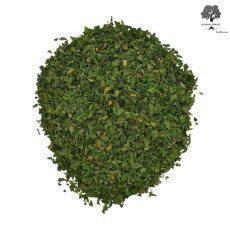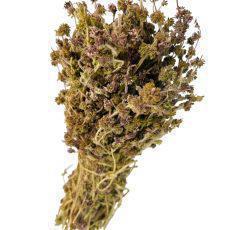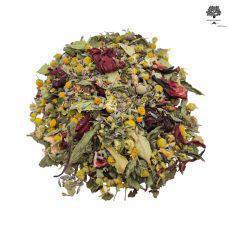Description
Dried Parsley of Εxceptional Quality.
The aroma is very strong and has wonderful dark green colour.
Class : AAA
Origin: Poland
Expiration Date: Provided on the bag
Origin and History
Parsley has been cultivated and developed over so many centuries that its precise origins are difficult to pinpoint, compounded by the probability that all the parsieys we know nowadays, bear little resemblance to their ancestors. The botanical name Petroselinum comes from the Greek word for stone, which is petro, given to parsley because it was found growing on rocky hillsides in Greece. Although the Ancient Greeks did not use parsley in cooking, it was revered as a symbol of oblivion and death and as a funeral herb.
According to legend, parsley sprang up where the blood of the Greek hero Archemorus was spilled when he was eaten by serpents. The Greeks used the herb to fashion wreaths for graves. The Romans are said to have used it at orgies to cover up the smell of alcohol on the breath, while also aiding digestion. And there’s the unflattering remark that was once made about those who looked as if at death’s door: “The man’s in need of parsley” (Corpses were sprinkled with parsley to deodorize them.)
Parsley is mentioned often throughout history, and not only for its culinary and medicinal properties. The early Greeks made crowns of parsley to bestow upon the winners of the Nemena and Isthmian sports games, in the same manner that bay wreaths honored the Olympians.
Parsley is used in the Hebrew celebration of Passover as a symbol of spring and rebirth. It is mentioned as one of the plants in the gardens of Charlemagne and Catherine de Medici. Rumor has it that Medici is responsible for popularizing parsley when she brought it back to France from its native Italy.
In medieval times parsley was surrounded by much superstition, one belief being that the long germination period for the seeds was due to them having to travel to hell and back seven times before sprouting. Superstitious farmers would refuse to transplant parsley and some were even too afraid to grow it at all.
Preparation and Storage
Fresh parsley, often the curly variety, is the most readily available of all fresh herbs. Buy bunches that are not wilted, with springy, erect, almost bristly leaves. Rinse thoroughly in cold water to remove any grit that may have become trapped in the curly leaves and squeeze dry. To store, either put the bunch of parsley in a glass of water then keep it in the refrigerator, or wrap the fresh sprays in foil and freeze them.
Dried parsley is best purchased in small amounts and regularly, as it loses its color and flavour rapidly when sitting on a supermarket shelf. Look for deep-green ‘flakes’ that are free from pieces of stalk and yellow leaves. Always store away from any source of direct light and keep in airtight packaging away from extreme heat and humidity.
Drying Parsley
Wash and drain the parsley on some paper towel and then place the sprigs on a microwave proof plate. Microwave for 30 seconds and then turn the sprigs over and blast another 30 seconds. Leave to cool and see if the sprigs are brittle – if they are, then crumble them into jars, if not, give them another 30 seconds.
Cooking with Parsley
There is very little that does not benefit from the addition of parsley — it’s good in stews, sauces, cheese spreads, rice dishes, vegetables, omelettes, and in fish dishes. It helps add color to pestos. Deep-fried, it makes an intriguing garnish. The ancient Romans combined parsley with cheese and bread for meals.
The fresh flavour and crisp mouth-teel ot parsley makes it an ideal accompaniment to most foods. It is traditionally featured in well-known herb blends like fines herbes (with chervil, chives and tarragon) and in bouquet garni with thyme, marjoram and bay leaves.
Fresh or dried parsley may be used in omelets, scrambled eggs, mashed potatoes, soups, pasta and vegetable dishes and in sauces to go with fish, poultry, veal and pork. It is included with garlic and butter for making garlic bread or simply garnishing a juicy, sizzling barbecued steak. Parsley is a key ingredient, along with mint in the healthy and nutritious Middle Eastern salad, tabouleh.
Flat-Leaved parsley is found in Moroccan dishes, from spiced tagines with preserved lemons, to dishes flavored by a chermoula blend that includes coriander leaves, onions, cumin and cayenne pepper. With its stronger flavour, it is more frequently used in cooking, particularly since it stands up well to heat. For instance, try using the stems rather than the leaves when you want the freshness of parsley in a white sauce but don’t want the color to bleed.
Persillade and gremolada are two well known sauces which have parsley as one of the main ingredients. Persillade, a French sauce, is a sauteed mixture of finely chopped parsley and garlic. It is added just before serving to broiled meats, particularly lamb and beef, as well as chicken or vegetables. Gremolada is a Milanese condiment made of sauteed parsley, garlic, lemon and orange zest. This mixture is traditionally spread over osso bucco just before serving, although it enhances any braised meats.








